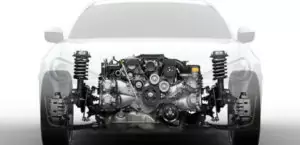The company introduced the 1.4-liter turbo engine Hyundai G4LD or 1.4 T-GDI in 2016. Since 2019, this motor has been included in the new Smartstream line, where it is known under the G1.4T index.
Kappa R4 family: G4LA, G4LF, G4LC, G4LD, G4LG, G4LH, G4LE.
In 2016, a 1.4-liter turbo unit appeared on the Elantra model for the American market. The first version developed 130 hp, but when the engine reached Europe it was raised to 140 hp. This is a typical power unit of the Kappa family with an aluminum block, cast iron sleeves, an aluminum 16-valve cylinder head with a direct fuel injection system and hydraulic lifters, a timing chain drive, and a Dual CVVT phase control system on two camshafts. The turbine of own production Hyundai Wia with the article 28231-03200 is responsible for supercharging.
The manufacturer initially equipped the engine with oil nozzles for cooling the pistons and revised the design of the exhaust manifold, so scuffing is almost never found here.
The engine was installed on:
- Hyundai i30 3 (PD) since 2017;
- Hyundai Creta 2 (SU2) since 2020;
- Hyundai Elantra 6 (AD) in 2016 – 2020;
- Hyundai Veloster 2 (JS) since 2018;
- Kia Ceed 3 (CD) since 2018;
- Kia ProCeed 3 (CD) since 2019;
- Kia XCeed 1 (CD) since 2019.
Specifications
| Production years | since 2016 |
| Displacement, cc | 1353 |
| Fuel system | direct injection |
| Power output, hp | 130 – 140 |
| Torque output, Nm | 212 – 242 |
| Cylinder block | aluminum R4 |
| Block head | aluminum 16v |
| Cylinder bore, mm | 71.6 |
| Piston stroke, mm | 84 |
| Compression ratio | 10.0 |
| Hydraulic lifters | yes |
| Timing drive | chain |
| Phase regulator | Dual CVVT |
| Turbocharging | Hyundai Wia |
| Recommended engine oil | 0W-30, 5W-30 |
| Engine oil capacity, liter | 4.5 |
| Fuel type | petrol |
| Euro standards | EURO 5/6 |
| Fuel consumption, L/100 km (for Kia Ceed 2019) — city — highway — combined |
7.7 5.2 6.1 |
| Engine lifespan, km | ~250 000 |
| Weight, kg | 92 (without attachments) |
Disadvantages of the Hyundai G4LD engine
- Since there are piston cooling nozzles and the problem with scuffing is not acute, the main reason for the appearance of a progressive oil burner is the ellipse of the cylinders. The aluminum block with thin cast-iron sleeves and an open cooling jacket has low rigidity, and the presence of a turbocharger only accelerates the deformation processes.
- The turbine units of the Korean concern use a reliable bush-roller chain, but it tends to stretch to 100,000 km if the engine is often turned to cutoff. It is good that the replacement of the chain is carried out by each service and is quite inexpensive.
- Like any direct injection engine, this one suffers from carbon deposits on the intake valves. It is also not uncommon for oil and coolant leaks to occur due to weak gaskets.






